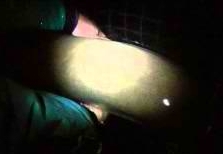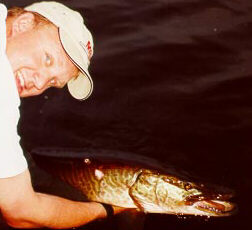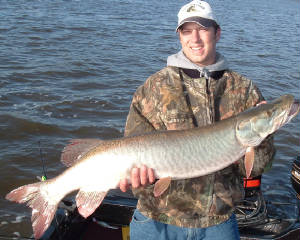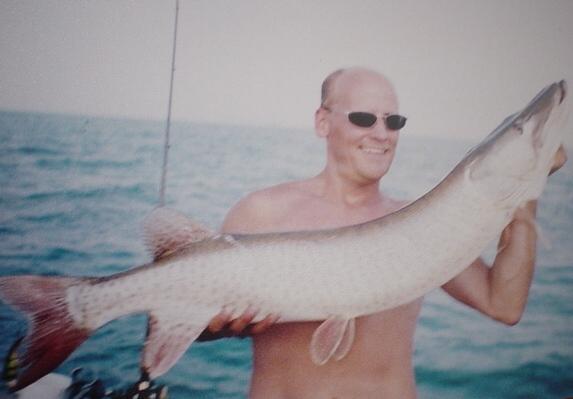|
|
| I was surfin' the web and found an interesting discussion on how fish camouflage themselves. Figured it might be interesting to consider when thinking about how our lures should be painted (upside down patterns have been discussed before). Perch bars for example help a fish conceal themselves in weeds. If this is true.... then wouldn't a perch pattern be a POOR choice when fishing a weed bed if we want our lure to be VISIBLE?
The discussion on countershading, however, is why I feel "extra" action is necessary with most of the popular color patterns on our lures today. I feel making the bait roll over and exposing its lighter underside is a visual que that muskies look for when selecting their next victim. I cut and pasted the info below for your enjoyment. Please share your thoughts.
Countershading refers to the colouration of many fishes that are darker on the back than on the sides and belly. With this arrangement, illumination from above lightens the back and the light coloration on the sides and belly lighten the shadows of the underside. This type of colouration is thought to help conceal the fish from predators.
Say a fish is dark colored on its dorsal side, and light colored on its ventral side, how is that an example of camoflauge? This type of colouration in fish is thought to be a form of camouflage because it helps them blend into their background whether you are looking at them from above or below. From above, the depths of the sea look very dark, so a fish needs to be dark on top in order to blend in. Light from the water surface will reflect off of the top of the fish, so a dark colour helps to correct for that.
If you look up from below the water looks very light, because the sunlight is shining into it. In order to blend in from this point of view, a fish needs to have a light-colored belly. This form of camouflage is called countershading. | |
| | |
| I'll have to let you know how it works Jason, have a twitchbait ordered from Divani that is painted upside down. Interesting concept, think I will try it. | |
| | |
| I have an interesting story about this. A couple of years ago I spotted a large fish at night on a jailbird jointed believer that I used as a topwater bait. I raised was I am pretty sure was the same fish 3 times in 10 days at the same time and she always missed until one day i decided to spray paint the belly of the believer black. Well to make a long story short I went back the same night and caught the fish on the first cast. There was no moon out on either nights I raised it and the night I caught it as well. So in the case of night fishing maybe the opposite would be true.
chrisA | |
| | |
| I'll also let you know how it goes. Just finished painting a rejuvenated Grandma bait with a white top and black sides.
Scott | |
| | |
| jlong,
Interesting post. My thoughts have always been to go natural in regards to color and pattern selection. I think that muskies are somewhat conditioned to key on natural triggers. This post has got me 2nd guessing myself. I have re-written this post 3 times becuase when I get to the end I dont completely agree with what I am writng. Hmmmm....there are good arguements for both sides. I think after I am done pounding my head on my desk tonight I will still START off with natural selections then try others.
MUSKY ILLINI
"Just because I don't care doesn't mean I don't understand."
O'BABY YOOOOOOOOOOUUUUUUUU! Got what I neeeeeeed.... But you say he's just a friend.[:p] | |
| | |
| Well? Did any of you who tried the "upside down" paint patterns in 2002 do any better? Did any of you find a certain pattern that moved more fish than the "others"?
I personally believe that if we want a more visible presentation, understanding the natural camoflage patterns that mother nature has refined over billions of years may be useful. Understanding the weaknesses of that camoflage and how predators have used those "signals" to find a meal has got to help. This way we can have a very NATURAL appearance with our offerings yet still be effective at attracting muskies. The best of both worlds in my book. Probably most applicable in clear water situations or high pressure... but something to consider none-the-less.
Those obnoxious fluorescents and other gaudy looking stuff are still proven fish catchers... but most likely are getting bit by aggressive fish.
I still think there is some serious merit to the upside down pattern... but looking for some real life testimonials. Is there a difference between a lure painted with an upside down pattern versus a regular perch flavored lure worked in a way that the light colored underside is "flashing"? Some call this "belly roll". Is it important?
jlong | |
| | |
| jlong:
Since I first wrote about "upside" paint jobs on jerk baits in Musky Hunter magazine, it has surfaced periodically on the muskie boards.
Obviously, I believe in it and wish lure makers did more of it. I HAVE had great success on upside down painted jerk baits. Don't use crankbaits much, but think they too would work great. Obviously too, your "belly roll" thought is/would accomplish basically the same thing. The whole idea/thought about it, at least in my mind, is CONTRAST/FLASH and getting the fish's attention!
Muskie regards,
Larry Ramsell
www.larryramsell.com | |
| | |
| How about vertical contrasts rather than horizontal contrasts?
If you study how animals, especially marine animals such as fish, utilize countershading and striping for camoflage (protection against predation) in order to NOT get noticed and becoming a larger fish's lunch..... you gotta question some of the popular color patterns on the market today.
Dots, tiger stripes, perch bars, and any of those beautiful lace patterns that people use on their lures thinking they are adding contrast to produce a more visible lure MAY actually be concealing their lure more!!!! Thus, I can't help but question whether many of todays most popular paint patterns actually make our lures more difficult for a fish to see.
If perch have bars to conceal themselves in the weeds or break up their profile in the shadows of the underwater world.... why would we want to mimick the natural camoflage of our quarry's prey with our presentations? This is why I firmly believe in doing something "extra" to our presentations to produce some sort of vulnerability signal. Take a cisco for example. The silver sides, dark top, and light undersides are designed to conceal them from predation from above (birds) and below (big fat muskies). However, roll a cisco on its sides when the sun is shining and you are almost blinded by the flash it produces. Thus, I think we need to complement our lure's action with the paint pattern/colors to accentuate these "natural" signals such as flash in order to get noticed and incorporate some good contrast (here's where Larry's upside down theory shines) to provide a good target.
Its the contrast part that I think most fishermen are confused with (including myself). I do not believe adding stripes, dots, and bars is the type of contrast we want if our goal is to offer the most visible presentation possible. These types of patterns increase the number of "edges" the predator must determine is part of their target or background.... which helps conceal your lure rather than make it easier to see.
I apologize for rambling my thoughts here... but I'd like to hear what everyone else thinks about this.
jlong | |
| | |
| Interesting concept here...not sure what I am thinking, but this is what I contemplate from it.
In clear water lakes with fish relating to both open water forage, and structure, I feel a natural presentation is best, since a fish theoretically can "study" (better word?) the forage, through following.
Jason, I like the concept of doing something a bit different to draw attention to the bait, and Larry's study on upside down is good. What sits in my mind though, is when you see a "dying" forage fish is it upside-down, or on it's side and struggling? I guess, what I would like to see is a bait painted sideways... The wiggle (crankbait or jerkbait presentation) would cause flash, and it would be out of place in the weeds. I could see this working really well with twitching and glider style baits.
In dark water, I am not sure that the contrast would be much of a factor, based upon the theory that fish need to sense the bait in another form first (vibration, sound, etc) to hone in on the bait. Then contrasting colors help with visual location. (assuming this is the reason that orange and chartreuse seem so popular and seem to work well for many in dark water situations..)
Good topic
Steve | |
| | |
| Hi Jason, I just got back two Twitchers from Lunker Lou that are all chewed up! He said they were his hot twitch baits last year. They were a Natural Perch and Holoform Walleye pattern. Both were painted upside down, Hmmm! I'll let you take it from here! [;)] TR | |
| | |

Posts: 1938
Location: Black Creek, WI | Well, Suick has given us the "sideways" pattern to experiment with in 2003. I'll be sure to get a few "upside down" TR Twitchers to try myself as well.
I just can't help but think perhaps the biggest benefit of an "upside down" pattern is for the fisherman and not the fish? You can see the lure in the water better... thus can more effectively present your lure and stay alert to a pending strike? On the flip side... this pattern may also be more visible to the fish???
Anyone willing to take these experiments to the extreme and fish with a clear (virtually invisible) lure? It sure would help determine if a more or less visible lure is most effective. The "invisible lure" concept has been talked about a lot last winter on some of the "Lateral Line" discussions and "instinctive strike" debates. Curious if anyone is crazy enough to test it out????
Maybe color doesn't make a difference to the fish... but we all know it helps give us confidence.... and confidence is always a key ingredient for success. I just don't think I'm confident enough myself to try some of these crazy color ideas. What do you guys think about all these "new" color options and considerations?
| |
| | |

Posts: 1938
Location: Black Creek, WI | MRoberts' post made me dig this on up, since I think it is directly related.
Schooling is a form of camouflage, correct? A zebra all by itself in a field has some concealment due to its vertical stripes creating multiple "edges" to help break up its profile against the background. In other words, making it more difficult to see. Put an entire herd of zebras together and it gets even more difficult to pick out a single animal.
All you duck hunters out there know that you don't shoot at the flock, but pick out a single bird to lay a bead on. So, if you want to create a better target (lure color).... wouldn't you create something easier to see? A single color lure should be best then, right? If so, than why do we catch so many fish on lures with stripes, bars, dots, etc.?
These two things seem to contradict one another! Perhaps there is more to this game than just the visual aspect? I believe a school of fish provides lateral line camouflage as well. Perhaps lure color or patterns are not even a factor for fish that are triggered to strike through the lateral line? This would support fishing the perimeter of baitfish schools, but still offers little to help with deciding whether to go with a natural vs. "shocker" color pattern.
Thus, I always error on the safe side. Visible yet natural. But, that isn't always easy to figure out. Perhaps MRoberts is onto something and maybe we should use those "shocker" colors more often????
Oh boy, its gonna be another long winter. Let's hear what others think about this!
jlong | |
| | |

Posts: 714
Location: Rhinelander, WI | Couple interesting things here. I remember reading this a while back, but not having time to respond.
I would guess Perch Bars work best as camo, when the fish is stationary, while moving they might be counter productive. Also consider schooling, which perch do on a regular basis. Is it possible that when schooling the bars help break up each individual fish, thus making the school appear as if it is made up of many more smaller fish.
Also some things to think about with the upside down patterns. J, you mention the Cisco and how it is concealed from the top by the black back and the bottom by the light belly. Well by turning the pattern around it is completely dropping that concealing effect and actually making the bait contrast more when looked at from below or above. It allows the fishermen to have better control because it can be seen and it should stand out more to the fish.
In regards to the question in the second paragraph of you latest post. Is it possible that the reason so many fish are caught on lures with stripes, bars, dots, etc., is because those are the color patterns most used. The old self fulfilling prophesy. Lets face it solid colors just aren’t sexy, infact I can’t think of one bait in my vast collection that is a single solid color, other than a few in black and even those I couldn’t leave alone and they either have holoform or chrome tape or silver glitter in the seal coat.
This may be something we truly need to try next year. I can see some solid orange, green, and black…………But even as I sit here and think about it I just can’t see throwing the solid color, but maybe that will be the reason it will be better. It’s different. I’ll need to get psyched up about this and give it true shot next year. I know I can spend some time tossing black………but can I spruce the solids up a bit with holoform to give it a little flash in the sunlight………. please.
And just for your reading pleasure since you brought it. The following was the paragraph immediately preceding the paragraph I posted in the Prey post. No reference to a specific scientist here so Crichton may have just made this up to prove the point his character was trying to make in the book so take it for what it’s worth:
“Over the last thirty years, scientists had studied predator-prey interactions in everything from the lion to the hyena to the warrior ant. There was now a much better understanding of how prey defended themselves. Animals like zebra and caribou didn’t live in herds because they were sociable; herding was a defense against predation. Large numbers of animals provided increased vigilance. And attacking predators were often confused when the herd fled in all directions. Sometimes they literally stopped cold. Show a predator too many moving targets and it often chased none.”
More reason to maybe keep that bait just on he outside of the school of bait. Often though we have no clue where the actual school is so this isn’t as easy as it sounds, or maybe it’s harder to actually keep the bait in the school in which case we are golden.
Nail A Pig!
Mike
Edited by MRoberts 12/16/2003 9:59 PM
| |
| | |
| WOW.....What a great "thinking" thread !!!! I have been fishing for many years with "Bassackwards" painted lures. I have never given it much of a thought until a few years ago.
I have been blessed with not having normal eyes. My stigmatism is not correctable and I need to wear glasses with a flat lense. Until recently prescription polaroids were very poor in quality. A glare in any condition was normal. Most of the time not wearing them was better than wearing them. This created a huge problem for me. I had a hard time seeing a lure approach the boat much less a follow.
I started painting the top half of all my jerks and cranks white or gray (whatever spray paint dad had laying around) back in the mid to late 80's. Not because I thought it would help me catch more fish, but to help me see the bait at boatside. I have caught many fish over the years on these lures no matter the condition. I have also caught many fish on traditional painted lures but these fish always came under conditions when the fish were "REALLY" biting. You know, the times when they are hitting everything.
This color scheme does work. "Especially" in tough conditions. Take one of your high confidence lures. You know the ones. The lures that actually catch fish. One of the 10 or so in yourstockpile of 150 and paint it "Bassackwards". The next time you cant move a fish anywhere give it a try. And I mean try it all day. What are you going to miss? The fish you werent seeing?
Mike
| |
| | |

Posts: 2068
Location: Appleton,WI | Would a lure painted backwards work? so the bait looks like its got a fast reverse going on??something to think about!
the tail painted as the head ect... ect.... | |
| | |
Posts: 1936
Location: Eau Claire, WI | So who tried the sideways Suicks..? Did they work as well, better, or worse..?
I fish a similar bait made by one of my sponsors called a Slow Tease. My best producers this year...solid sucker color (brown/bronze) and chartreuse with a few spots. I fish mainly stained (not dirty) water. 90%+ of the strikes came while the bait was in pause/hang mode ( as if it were a bait fish trying to remain still and not be noticed). Coincidence..?
If upside down painted baits work better then does that give more credability to the old adage, "any color is good as long as it's black"...?
Since Muskies visual spectrum is to look horizontaly and upwards then the color of the top of the bait shouldn't really matter...unless you can give it some side roll or flash, or does it matter (other than giving the angler a brighter color to better keep track of the bait).
More stuff to keep me awake at night...hehe
Edited by Mark H. 1/2/2004 12:21 PM
| |
| | |

Posts: 1938
Location: Black Creek, WI | This link provides some very nice images, photos, etc. on this topic. Worth taking a look at...
http://www.schools.net.au/edu/lesson_ideas/optics/optics_wksht4_p1....
| |
| | |

Posts: 32944
Location: Rhinelander, Wisconsin | Shoaling behavior doesn't achieve camo effect as much as create targeting confusion and allow for a mechanism to determine the 'state' of predators in the immediate area.
The minnows in my tank sometimes move in absolute concert when cruising about, creating a large, flowing nearly single mass. In my observations that doesn't seem to effect the predator's ability to pick out a target at all, but theory is that the behavior is anti-predator.
Key to consideration with the idea of counter shading or upside down painting is again that paint, no matter how nice it looks, will never actually do what the fish's scales and coloration can and does do. Add to that the problem with what the paint base color might be, and the fact the paint job is created for OUR eyes to sell the lure based on anthropomorphism, and one begins to sharpen the perspective on color and contrast.
The last thing I want is the lure to look 'natural', as impossible as that is. Strike response is what I am after, or in the case of a perfectly timed trip, feeding behavior accentuated by a strike response trigger. The bait can be painted in any pattern or color and be effective to some degree, because NO color we can create in paint totally disappears in the marine environment. There will always be some contrast, and of course the hooks and hardware are there probably getting enough of the job done.
In short, I want the lure color to do exactly opposite what a Perch's natural coloration does. Easy to do with ugly lures. The problem is ugly lures do not sell.
| |
| | |
Posts: 57
Location: Racine WI | This is "sort-of" on-topic. At the Milwaukee Expo I saw baits painted in "normal" colors, but with a very contrasting color/pattern on each side, so they look like two different lures when vierwed from the left or right. The slogan was something like "fish two lures on one line." ANYWAY, that wasn't the point I wanted to deal with. Among these high contrast baits was a Believer painted in an alternating checkerboard of black and yellow. Super contrast -- it looked like a highway caution marker or police line around an accident. Which got me thinking. We use black-and-yellow caution signs because Ma Nature has conditioned us to associate the color/pattern with danger. Venomous critters, from bumblebees to sea snakes to poison dart frogs, give clear warning with black and yellow patterns. (Or black-orange, like monarch butterflies; sometimes black-red like Bombina toads -- who have a back-arching posture [the "unken reflex"] to display their underside, which gives them their common name: fire-bellied toads.) Now we all know the muskie is the meanest s-o-b in the valley, but I wonder if we're only pushing the buttons of seriously bad-tempered fish with these venom colors? Any thoughts about high-contrast that does not involve black and yellow/orange/red? | |
| | |

Posts: 1137
Location: Holly, MI | Bringing up an oldie here but couldn't help myself. Attached is a pic of a bait in progress (now done), an upside down perch. I like the thoughts of the visability being increased for both the fisherman and the fish. My stronger thought however is that it will appear as a wounded or dying bait fish. The response to attack a wounded meal should be that much stronger than a healthy stronger prey. I have yet to fish the lure but it sure danced around nice in wet testing. Mostly luck on my part as jerk baits are new for me to try making. It sinks real slow and jumps to the sides with each jerk.
Some great opinions and discussion on this post. It just shows how little we know about these crazy fish. The more we learn, the more questions we come up with.
Attachments
----------------
 Upside Down Perch.jpg (138KB - 192 downloads) Upside Down Perch.jpg (138KB - 192 downloads)
| |
| |
|
 Fish Camouflage
Fish Camouflage Fish Camouflage
Fish Camouflage